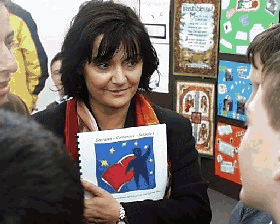 International dialogue
International dialogue
In January 1998 St Aidans teachers and students became involved in a European Union sponsored ‘Socrates-Comenius’ project fostering dialogue and communications between young people across Europe through the medium of ICT. Teachers and students from three countries, Slovakia, Spain and Ireland were involved. The project was entitled “Our Lives: A comparison of School Life and Leisure Activities: The Ideal European School and Lifestyle” (St Aidans Comenius Report 1999).
The North/South schools link came into an environment which was already focusing on students taking control of their own lives though dialogue and communication through the medium of ICT. The Comenius project 'A comparison of school life and Leisure time' involved students from the three counties working with fellow students and teachers to research and examine their own culture and engage with students and teachers from other countries in reflecting on how their cultures compared.
The work of the project was carried out by direct communications and dialogue. This can be seen in the videos of students from Slovakia and Ireland meeting and presenting their in Dublin in 2001 and in the video of the video conference taking place between students and students, teachers and teachers, students and international leaders in Dublin in 1999. these international meetings were just two of ten that took place as part of the project. The video conferences were part of a series where students communicated. But communications media including written letters, email, online chat and developing web sites.
Experience of the Comenius projectStudents and teachers taking part in the Comenius project commented: "The worst thing of this project was the time because for example the school in Dublin ends in May. The best thing was that we have found new friends and have tried out new ways of communication." "I have never thought it would be so exciting. The project let us know many interesting things and made us think about the differences between the countries." "The first year of our European Education Project has been a tremendous success. Teachers and students alike, in each of the four participating schools have been enriched by this cultural interchange." "This project gave me a lot of new knowledge about Ireland and Spain. I know a lot about their habits, a style of living and of course I ’ ve improved my English. I have a lot of new friends and it will be very good, if it continues." "We have worked in groups with our classmates and have increased our friendship and mutual understanding." "Comenius has helped me to bond with my classmates. I love feeling part of a group and that I’m helping to achieve something." "The tasks and activities have also helped me to take a greater look at myself, my culture and my country.""One of the most important features of this project is the fact that except the "official" or planned part, that is the work on the individual project topics, there also existed the informal, non-planned part. I mean the correspondence among the students involved in the project concerning out- of-project themes and communication. A similar feature occurred in the work of the coordinators." (St Aidans 1999) These comments from the participants in these projects are evidence of the changing practice and as a result of that changing practice changes in understanding of others and changes in self perceptions. One student came to see himself as being a part of history another had increased friendship and understanding. Evidence from the Comenius project |
Evidence of new practiceThe North/South schools link video-conference moved students out of their ‘bolt down seats’ (Cook-Sather, 2002: 3) and introduced them to a world stage as they shared their ideas and challenged the ideas of Prime Ministers. The collaborative dialogue continued with video-conferences with Members of the European Parliament, with students in a range of schools in Northern Ireland and the Republic of Ireland. Subsequently conferences took place with schools in Sweden, Slovakia and Spain. Several conferences took place through the medium of the Irish language. One conference was given over to students sharing their musical interests, not by speaking about music, but by playing music. Surely two classes of students, one in Omagh and the other in Dublin playing their music for each others benefit is a form of intersubjectivity? These are all new practices. These are practices that offer a virtual ideal speech situation (Habermas 1984) where people can communicate freely and gain understanding of each other though dialogue. The images at the top of this page are of photographs taken at the Comenius meeting in Dublin on 3 May 1999. The meeting was a celebration of the work of students from three countries. Photographs show students interacting demonstrating the evidence of their work through the publication "A Comparison Of School Life And Leisure Time" The report of the projects work was published both in hard copy and electronically. Another photograph shows the students taking part in a video conference with students from Loreto Grammar School, Omagh. Yet another photograph shows two candidates for the European Parliament, Ben Briscoe T.D. and Proinsias de Rossa engaged in a conference with the Loreto students. Another photograph shows three teachers Marian (Bratislava, Slovakia) Zuzana (Humenne, Slovakia) and Bernardo (Madrid, Spain) taking part in a video conference with students in Omagh. |


